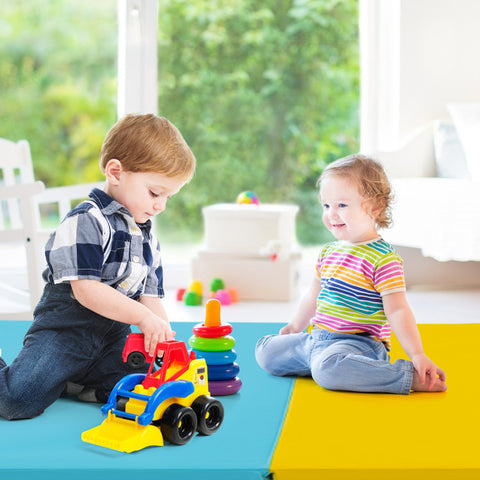News
The Role of Anti-Slip Surface Technology in Gymnastics Mats: Ensuring Stability and Safety for Athletes
Gymnastics is a sport of precision, balance, and strength, and even the slightest slip can result in serious injury. While most people focus on the foam density or thickness of gymnastics mats, one key yet often overlooked feature is surface grip. The anti-slip surface technology used in modern gymnastics mats plays a critical role in athlete safety, performance, and longevity of the mat itself.
This article explores how this innovative characteristic enhances athletic stability, reduces the risk of injury, and contributes to better training outcomes.
1. Understanding Anti-Slip Surface Technology
Anti-slip surface technology refers to the specialized textures, coatings, and materials designed to create friction between the athlete’s feet or hands and the mat surface. It prevents unintentional slipping during tumbling, landing, or stretching exercises.
Most high-quality gymnastics mats now feature PVC leather, textured vinyl, or urethane coatings that provide both comfort and traction, even under conditions of sweat, dust, or prolonged use.
2. How Surface Grip Affects Performance
Athletes rely heavily on consistent footing for routines that require balance, flips, or rolls. When the mat’s surface grip is optimized:
- Improved Stability: Athletes can perform with confidence, maintaining better control during movement transitions.
- Reduced Muscle Strain: Less energy is wasted on preventing slips, allowing gymnasts to focus on technique.
- Higher Training Efficiency: With consistent grip, sessions become safer and more productive.
A mat with poor grip, however, can lead to overcompensation, poor landings, and a higher chance of sprains or falls.
3. Materials That Enhance Grip
Different mat manufacturers use various surface materials to balance traction, durability, and comfort. Common examples include:
- Textured PVC Surface: Offers long-lasting anti-slip properties with easy cleaning.
- High-Density Vinyl: Provides a softer yet firm grip for both bare feet and footwear.
- Polyurethane Coatings: Known for their resistance to wear and moisture, ideal for high-use gym environments.
These materials are often layered with foam cores to absorb shock while maintaining a consistent surface grip.
4. Anti-Slip Mats and Injury Prevention
Falls and slips are among the most common causes of sports-related injuries. Anti-slip surfaces help minimize these by:
- Preventing ankle rolls and knee twists during takeoffs or landings.
- Supporting proper foot alignment during balance routines.
- Reducing impact stress through surface consistency.
In rehabilitation settings, such mats also support safer low-impact exercises for seniors or recovering athletes.
5. Maintenance and Longevity of Grip Surfaces
Proper maintenance is essential to retain the anti-slip properties of a gymnastics mat. Here are key tips:
- Regular Cleaning: Sweat, chalk, and dust can reduce grip efficiency.
- Avoid Harsh Chemicals: Use mild detergents and soft cloths to preserve texture.
- Store Properly: Keep mats rolled and dry when not in use to prevent moisture buildup.
Well-maintained mats can retain their grip integrity for several years, even under heavy use.
6. Choosing the Right Anti-Slip Gymnastics Mat
When selecting a gymnastics mat, consider:
- Surface Texture: Look for mild texturing or grain patterns for optimal friction.
- Test Underfoot: Ensure grip feels consistent across all directions.
- Durability Certification: Check for materials tested for anti-slip resistance and wear performance.
Brands that specifically advertise anti-slip or textured finishes tend to offer better safety assurance for both home and professional use.
Conclusion
The anti-slip surface of a gymnastics mat may seem like a small detail, but it has a significant impact on performance, safety, and confidence. Whether used by professional athletes or beginners, a mat with advanced surface grip technology ensures stability and minimizes injury risk.
Investing in a high-quality anti-slip gymnastics mat is not just about comfort — it’s about enhancing your overall training experience and protecting your body with every move.
Frequently Asked Questions (FAQs)
1. What makes a gymnastics mat anti-slip?
The surface material — usually PVC or textured vinyl — provides friction to prevent slipping during exercises.
2. Can anti-slip mats wear out over time?
Yes, excessive dirt, sweat, or improper cleaning can reduce grip. Regular maintenance preserves their effectiveness.
3. Are anti-slip mats suitable for home workouts?
Absolutely. They provide excellent safety for yoga, stretching, tumbling, and balance training.
4. How do I clean an anti-slip gymnastics mat?
Use a soft cloth with mild soap and water. Avoid alcohol-based cleaners that can erode the surface coating.
5. Do anti-slip mats work on all floor types?
Yes, but placing them on flat, dry surfaces ensures maximum grip and stability.


